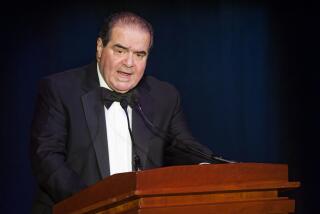Court’s new tilt could put Scalia on a roll
WASHINGTON — It has been two decades in the making, but this is the year Justice Antonin Scalia, the Supreme Court’s most outspoken dissenter, could emerge as a leader of a new conservative majority.
Between now and late June, the court is set to hand down decisions in four areas of law -- race, religion, abortion regulation and campaign finance -- where Scalia’s views may now represent the majority.
In each of those areas, the retirement of centrist Justice Sandra Day O’Connor and her replacement with Justice Samuel A. Alito Jr. figure to tip the court to the right. That would give the 70-year-old Scalia the chance to play a part that has largely eluded him: speaking for the court in major rulings.
Scalia does not see shades of gray in most legal disputes; instead, he favors clear rules and broad decisions.
A series of broad-brush rulings could put Scalia’s stamp on some key American social issues. A Scalia-led majority would move to outlaw the use of racial guidelines to achieve integration, allow a greater role for religion in public life, more tightly regulate abortion, and strike down campaign-funding laws seen as constricting free speech.
It is a prospect dreaded by liberals, and eagerly awaited by many on the right.
“I’m looking forward to the next 10 to 12 years,” said Terry Eastland, the publisher of the conservative Weekly Standard.
Though his majority opinions have been few, Scalia has been anything but silent in his long career. His influence has been considerable, especially for a generation of lawyers inspired by his championing of “originalism” -- strict adherence to the original meaning of the words in the Constitution.
“Justice Scalia has had a bigger impact off the court than on it,” said law professor Michael Gerhardt of the University of North Carolina. “In his speeches and his opinions, he is trying to reach a wider audience.”
Scalia does not grant media interviews, but in recent years he has spoken regularly at colleges and law schools, and he rarely fails to make news with an off-the-cuff comment. When asked to explain his role in the Bush vs. Gore decision that halted Florida’s recount in the 2000 presidential race, his standard rejoinder is: “Get over it.”
*
“I’m a textualist. I’m an originalist. I’m not a nut,” he told students at Claremont McKenna College this month.
His dissenting opinions have won him “a nearly cult-like following among many conservatives,” said author Kevin A. Ring, whose book “Scalia Dissents” contains the justice’s writings in a dozen areas of law.
Still, much more than memorable dissents were predicted when the Senate unanimously confirmed Scalia, then a federal appellate judge, to the high court in 1986. A former law professor, he was seen as smart, witty and charming. Many thought he would lead a conservative counterrevolution.
But he has not quite lived up to early expectations.
His temperament may be to blame, George Washington University law professor Jeffrey Rosen says in a new book accompanying a PBS series on the Supreme Court. Rosen writes that Scalia’s acerbic style and his know-it-all manner have turned colleagues against him.
Scalia’s conservative admirers say the blame lies not with him but with other Republican-appointed justices, such as Anthony M. Kennedy, David H. Souter and O’Connor, who turned out not to be true conservatives.
“He is not a split-the-difference type of jurist, and he has needed one extra person on his side,” Eastland said. “Consider how different it would have been had Bork been confirmed.” In October 1987, conservative Robert H. Bork, then a federal appellate judge, was rejected for the Supreme Court seat that Kennedy eventually filled.
With Bork at his side, Scalia and then-Chief Justice William H. Rehnquist would have had a majority to overturn Roe vs. Wade in the early 1990s. Instead, they fell one vote short.
Even when in the majority, Scalia has written relatively few major opinions for the court. Rehnquist, during his tenure as chief justice from 1986 to 2005, rarely turned to Scalia, because doing so risked losing the crucial votes of moderates, in particular O’Connor and Kennedy.
Often Scalia and his primary ally on the court, Justice Clarence Thomas, have sought to go further on opinions than the rest of the majority.
But last year, there were signs of change. The new chief justice, John G. Roberts Jr., turned to Scalia to write two key opinions.
One concerned whether drug evidence should be thrown out because the police, with a search warrant, had rushed into a house. Scalia’s opinion not only upheld the evidence but cast doubt on the future of the exclusionary rule, the doctrine that says illegally seized evidence is generally inadmissible.
And when given a chance to write a decision on wetlands, Scalia’s opinion cast aside 30 years of environmental law and largely limited the federal clean-water authority to “navigable” waterways.
In both cases, Kennedy wrote separate opinions that undercut Scalia’s views.
*
In sessions that begin today, this term will give Scalia a chance to make a mark in several areas in which Kennedy usually sides with conservatives.
For example, Scalia has scorned the notion of a strict separation of church and state, saying the 1st Amendment was intended only to bar the government from supporting an official national religion. In his first year on the court, he defended the teaching of creationism in the public schools, and he has voted regularly since then to allow the government to promote religion in general.
On Feb. 28, the court will hear a challenge to the White House Office of Faith-Based and Community Initiatives. A Wisconsin group called the Freedom From Religion Foundation and three taxpayers sued, casting the program as unconstitutional propaganda for religion.
The justices will hear the Bush administration’s claim that taxpayers lack the legal standing to challenge how the president and his advisors conduct affairs. A Supreme Court assent could make it much harder for critics to legally challenge government programs that promote religion.
On campaign finance, Scalia has argued that such laws unconstitutionally infringe on the free-speech rights of donors and candidates. In late April, the court is to hear a new challenge to the part of the McCain-Feingold law that forbids corporation- and union-funded broadcast ads that mention a federal candidate in the month or two before the election. A broad, Scalia-style opinion could cast doubt on most laws on campaign funding.
Scalia also has called for a ban on the use of race as a decision-making factor by government agencies, including public universities and other public schools. Without fail, he has voted against affirmative-action policies, but because of O’Connor, previous court majorities stopped short of outlawing affirmative action.
In December, the justices heard a challenge to the use of racial integration guidelines by school districts in Seattle and Louisville, Ky. A decision on that issue, due soon, gives the court’s conservative bloc a chance to broadly reject race-based policies.
Also pending is the challenge to the federal Partial-Birth Abortion Ban Act outlawing a midterm abortion procedure. This case does not call into doubt the basic right to abortion set in Roe vs. Wade; but a broad ruling in favor of the ban could trigger more stringent regulation of abortion across the nation.
Scalia has repeatedly called for overturning Roe vs. Wade and letting states decide whether to permit abortion.
*
The heart of Scalia’s message is that much of what the Supreme Court has done in recent decades amounts to an illegitimate power grab.
The justices overstep their authority when they stretch the Constitution to resolve current controversies, he says. Issues such as abortion, gay rights and the death penalty should be decided by voters and elected lawmakers, not by judges, he argues.
“I’m one who believes the Constitution should be interpreted exactly as it was adopted,” he said in a recent speech. “It should be interpreted as it was written -- nothing more, not less.”
Liberal law professors say originalism is more effective as a slogan than as a formula for shaping legal opinions.
“It is a good for public relations, and it’s good to put in speeches, but it doesn’t work in deciding cases,” Harvard University law professor Mark Tushnet said.
Scalia’s critics also say he has not consistently followed his own principle.
For example, Scalia has regularly voted in favor of white males who have challenged affirmative-action policies that benefit blacks, Latinos or women. He has done so on the basis of the 14th Amendment, adopted after the Civil War, which says no state may deny any person “the equal protection of the laws.” Originally, the amendment was intended to protect blacks from discrimination by Southern whites.
The Constitution puts no such “equal protection” restriction on Congress or the federal government. Yet when white contractors sued in the 1990s to challenge federal policies that benefited minorities, Scalia voted to strike down the policies as unconstitutional, though neither the words nor the history of the Constitution prohibited such programs.
Scalia’s use of originalism “tends to persuade those who already agree with him,” said liberal constitutional-law professor Erwin Chemerinsky of Duke University, but “it doesn’t persuade those who disagree with him.”
*
*
(BEGIN TEXT OF INFOBOX)
‘I mean, it’s crazy’
* Dissenting when the court upheld an affirmative-action policy at a state-supported law school (Grutter vs. Bollinger, 2003): ” ... The University of Michigan Law School’s mystical ‘critical mass’ justification for its discrimination by race challenges even the most gullible mind. The admissions statistics show it to be a sham to cover a scheme of racially proportionate admissions.”
* Dissenting when the court struck down a Texas law that made private sex between same-sex adults a crime (Lawrence vs. Texas, 2003): “Today’s opinion is the product of a court ... that has largely signed on to the so-called homosexual agenda, by which I mean the agenda promoted by some homosexual activists directed at eliminating the moral opprobrium that has traditionally attached to homosexual conduct....
“The court has taken sides in the culture war.... “
* Dissenting when the court struck down a state law that made “partial-birth abortions” a crime (Stenberg vs. Carhart, 2000): “Today’s decision, that the Constitution of the United States prevents the prohibition of a horrible mode of abortion, will be greeted by a firestorm of criticism -- as well it should.”
* On “originalism” and relying on text and history of the Constitution, in a talk at the Woodrow Wilson Center in Washington, 2005: “On occasion I’m asked ... ‘Justice Scalia, when did you first become an originalist?,’ as though it is some kind of weird affliction that seizes some people: ‘When did you first start eating human flesh?’ ”
* Asked at Switzerland’s University of Freiburg in 2006 about the U.S. policy of holding prisoners at Guantanamo Bay: “I had a son on that battlefield, and they were shooting at my son, and I’m not about to give this man who was captured in a war a full jury trial. I mean, it’s crazy.”
* Explaining in a letter to the Boston Herald in 2006 his gesture of flicking his fingers under his chin to a reporter who tried to question him when he was leaving Sunday Mass: “From watching too many episodes of ‘The Sopranos,’ your staff seems to have acquired the belief that any Sicilian gesture is obscene -- especially when made by an ‘Italian jurist.’ (I am, by the way, an American jurist.)”
More to Read
Get the L.A. Times Politics newsletter
Deeply reported insights into legislation, politics and policy from Sacramento, Washington and beyond. In your inbox three times per week.
You may occasionally receive promotional content from the Los Angeles Times.











